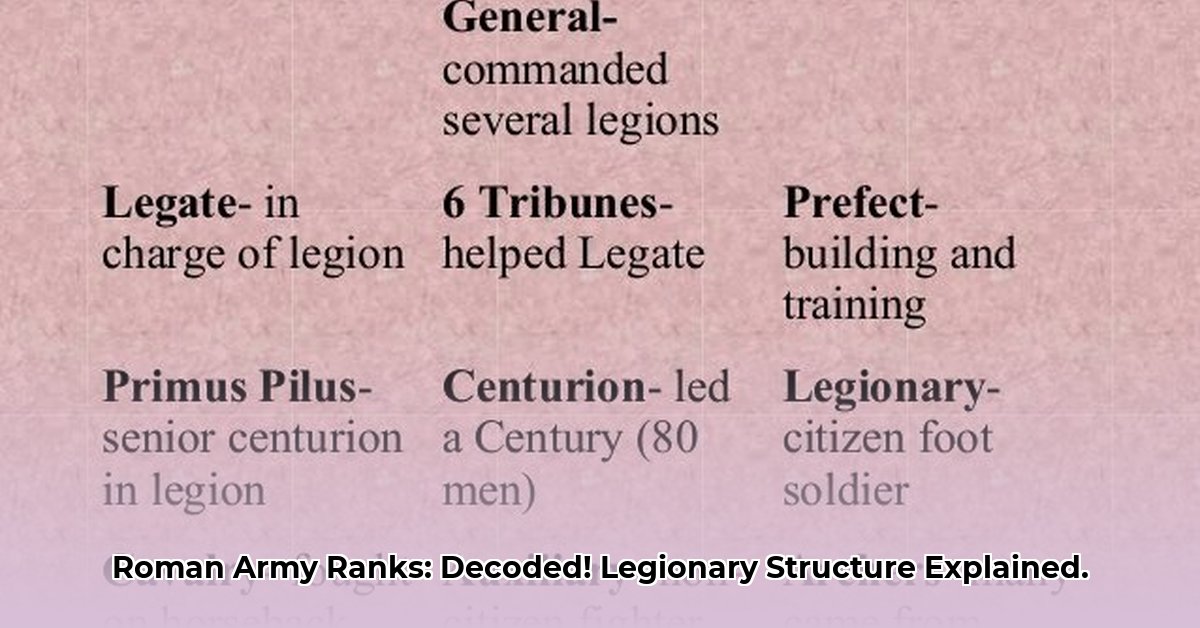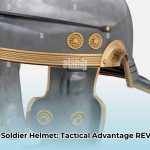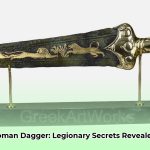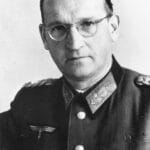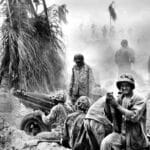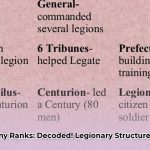Have you ever wondered about the intricate machinery that powered the unparalleled conquests of ancient Rome? It wasn't merely brute strength; it was the meticulous organization of the Roman army, a sophisticated system where every soldier, from the common recruit to the highest commander, understood their precise role and responsibilities. This detailed guide unveils the `Roman military hierarchy`, providing a complete roadmap to the `legionary structure`, the `Roman army ranks`, and the relentless `military training` that molded the most formidable fighting force of the ancient world. You can explore [Roman legion ranks](https://www.lolaapp.com/ancient-rome-army-ranks/) in more detail.
## The Iron Backbone: Foundations of Roman Military Organization
The `ancient Roman army` transformed from a seasonal citizen levy into a highly professional, long-service fighting machine, a transformation critically spearheaded by reforms like those of Gaius Marius. At its heart lay the `legion`, a versatile and adaptable unit that served as the primary combat force. While precise numbers fluctuated throughout Roman history, a full-strength legion typically comprised 4,200 to 6,000 highly trained `Roman soldiers`, a number that often included essential non-combatants such as engineers, medical staff, and administrative personnel. This numerical flexibility allowed legions to adapt to diverse strategic demands across the vast Roman Empire.
### Deconstructing the Legion: Units Within Units
The `legionary structure` was a masterclass in modular design, allowing for both precise control and tactical flexibility on the battlefield. Understanding these foundational units is key to comprehending the `Roman military hierarchy`:
* **Contubernium (Tent Group):** The smallest unit, consisting of eight men who shared a tent and often provisions. This fostered immediate camaraderie and mutual reliance. The senior and most experienced man in this group was often a `Decanus`.
* **Centuria (Century):** Composed of ten *contubernia*, totaling 80 men. Each century was commanded by a `Centurion`, the foundational leader of the Roman army.
* **Cohors (Cohort):** A larger tactical unit, traditionally made up of six centuries, amounting to 480 fighting men. The prestigious First Cohort of a legion was often double-strength, featuring only five centuries but with 160 men each, making it the elite vanguard.
* **Legio (Legion):** The paramount combat formation, typically consisting of ten cohorts. Additionally, each legion was often supported by a small, attached `cavalry` unit, the *Eques Legionis*, used primarily for scouting and messaging.
The strategic dispersal of these cohorts within battle formations was carefully planned; for instance, the First Cohort comprised elite troops, while others might include newer recruits. This careful distribution maximized morale and effectiveness across the entire `Roman legion`.
## From Recruit to Commander: Navigating Roman Army Ranks
The `Roman army ranks` were meticulously structured, reflecting both social standing and military experience. This system ensured a clear `Roman command structure` stretching from the raw recruit to the supreme legionary commander.
### The Rank and File: Legionaries and Auxiliaries
**Key Insights:**
* `Legionaries` were the backbone, common foot soldiers undergoing rigorous `military training`.
* `Tirones` (recruits) endured months of intensive physical and combat readiness drills.
* `Munifex` (common soldiers) performed the bulk of labor and combat.
* `Auxiliaries` were non-citizen forces providing specialized skills and expanding the army's reach.
At the base of the `Roman military hierarchy` stood the `Legionary` (*Munifex*). These were the backbone, the primary combatants responsible for direct engagement in battle, armed with their iconic *gladius* (short sword), *pilum* (javelin), and *scutum* (large rectangular shield). Before becoming a full *Munifex*, a `Tiro` (raw recruit) underwent several months of brutal yet essential `military training`. This comprehensive regimen included extensive marching (up to 20-25 miles a day with full kit), rigorous weapons drills with heavier practice equipment, and mastering complex tactical formations like the *testudo* (tortoise formation) and *triplex acies* (triple line formation). Discipline was paramount, enforced with unyielding strictness.
Complementing the legions were the `Auxilia`—non-citizen units recruited from the provinces. These forces, often cavalry, archers, or specialized light infantry, played a crucial role in expanding Rome's strategic capabilities. Upon honorable discharge after typically 25 years of service, auxiliaries and legionaries alike could receive Roman citizenship, a powerful incentive.
### The Non-Commissioned Backbone: Principales and Centurions
**Key Insights:**
* `Principales` were experienced non-commissioned officers, vital for daily operations.
* `Optio` served as the `Centurion's` second-in-command, maintaining order from the rear.
* `Signifer` (standard bearer) and `Aquilifer` (eagle bearer) held prestigious, morale-critical roles.
* `Centurions` were the indispensable middle management, combining leadership, discipline, and tactical acumen.
* `Primus Pilus` was the most senior `Centurion`, a pivotal figure on the cusp of equestrian status.
Above the common legionaries were the `Principales`, the senior non-commissioned officers equivalent to modern NCOs. These included:
* **Optio:** The `Centurion's` second-in-command. Positioned at the rear of the century, the *Optio* ensured men held their lines and executed orders, often using a wooden staff to reinforce discipline.
* **Tesserarius:** Responsible for the century's guard duty and distributing the daily watchwords (*tesserae*).
* **Signifer:** The standard bearer who carried the century's *signum*, a spear adorned with medallions and an open hand symbolizing the oath of loyalty. This was a crucial rallying point in battle.
* **Aquilifer:** The most prestigious standard bearer, entrusted with the legion's sacred *aquila* (golden eagle standard). Its loss was an immense dishonor, and its retrieval a source of immense pride.
* **Cornicen / Tubicen:** Horn and trumpet players who conveyed commands through specific signals amidst the din of battle.
* **Immunes:** Specialists (e.g., engineers, medics, blacksmiths, clerks) exempt from regular labor due to their vital skills.
At the very heart of the `Roman military hierarchy` were the **Centurions**. These seasoned, professional officers commanded a century of 80 men. Their responsibilities were vast: rigorous daily `military training`, relentless discipline enforcement, logistical oversight, and leading from the front in battle. Identifiable by their transverse helmet crests and carrying a *vitis* (grapevine staff)—a symbol of their authority used for punishment—`Centurions` bore the brunt of battle, often suffering high casualties due to their front-line leadership. They were typically promoted from the ranks, though sometimes directly appointed based on merit.
Within the `Centurion` ranks, a further hierarchy existed. The *Primi Ordines* were the five `Centurions` of the elite First Cohort, outranking all others. The pinnacle of their career was the `Primus Pilus` (First Spear), the senior `Centurion` of the entire legion, commanding the first century of the First Cohort. This position was a stepping stone into the equestrian social class upon retirement, reflecting its immense prestige and the value placed on practical military experience.
### The Equestrian Officers: Bridging Social Divides
**Key Insights:**
* `Tribuni Angusticlavii` (narrow-stripe tribunes) were equestrian officers, serving as administrative and staff officers.
* They gained valuable pre-legionary experience commanding auxilia.
* Their role provided a path for military and political advancement for non-senators.
The next tier was often filled by the `Equestrian` class, Rome's prosperous non-noble elite. `Tribuni Angusticlavii` (narrow-stripe tribunes) filled five of the six tribune positions in each legion. These officers, identifiable by the narrow purple stripe on their tunics (*angustus clavus*), generally served as crucial administrative and staff officers, assisting the senior command. Many had prior command experience as *praefecti* (commanders) of auxiliary cohorts, which prepared them for the complexities of legionary operations. This role provided a vital avenue for ambitious equestrians to gain military experience, a critical component of the *cursus honorum* (path of honors or political career).
### The Senatorial Elite: The Highest Command
**Key Insights:**
* `Legatus Legionis` commanded the entire `legion`, a high-status senatorial appointment.
* `Tribunus Laticlavius` was the `Legatus'` second-in-command, a young senator gaining experience.
* `Praefectus Castrorum` (camp prefect) was an experienced veteran, overseeing logistics and administration.
At the apex of the `Roman military hierarchy` were the senatorial officers, drawn from Rome's highest social class:
* **Tribunus Laticlavius:** The `Legatus'` second-in-command. This position was typically held by a young man (late teens/early twenties) of senatorial rank, identifiable by the broad purple stripe (*laticlavius*) on his toga. His role was primarily to gain military experience, a mandatory step for a political career.
* **Legatus Legionis:** The supreme commander of an entire `legion`. Appointed by the Emperor or Senate, the `Legatus` was typically an experienced senator in his early thirties, holding command for three to four years. In provinces with only one legion, the `Legatus` also served as the provincial governor, showcasing the intertwined nature of military and political power.
* **Praefectus Castrorum (Camp Prefect):** Uniquely, this high-ranking officer was usually a long-serving veteran, often a former `Primus Pilus`, who had risen through the ranks. The `Praefectus Castrorum` was the third-in-command, responsible for the construction, maintenance, and defense of the legion's camp, as well as overseeing logistics, equipment, and training readiness. His practical experience was indispensable to the higher, often less militarily experienced, senatorial officers.
* **Legatus Augusti pro Praetore:** The highest military rank, a senatorial governor of an entire province, commanding all legions within that territory. This role combined vast military and political authority.
## The Legionary's Life: Equipment and Daily Routine
The `Roman soldier` was defined not only by his `Roman army rank` but also by his standardized `equipment` and the rigorous daily routines that forged unbreakable discipline.
### The Arsenal: More Than Just a Sword
Every `legionary` was equipped for maximum effectiveness and protection:
* **Armor:**
* **Lorica Segmentata:** The iconic segmented plate armor, offering superior protection and flexibility.
* **Lorica Hamata:** Chainmail, a flexible and widely used alternative.
* **Lorica Squamata:** Scale armor, providing overlapping protection.
* **Weapons:**
* **Gladius:** The short, double-edged sword, ideal for thrusting in close-quarters combat.
* **Pilum:** A heavy javelin designed to pierce shields and armor before impact, often bending to render the enemy shield useless.
* **Pugio:** A versatile dagger, a crucial secondary weapon.
* **Shield:**
* **Scutum:** A large, curved rectangular shield, constructed of wood and covered with leather, providing excellent protection against projectiles and forming the basis of the *testudo* formation.
`Centurions` and officers wore distinct gear, including ornate helmets with transverse crests for `Centurions`, finer cloaks, and specific daggers or short swords like the *parazonium*.
### Life in Camp and on the March
A `Roman soldier's` life extended far beyond battle. When not campaigning, legions maintained `fortified camps` constructed with remarkable speed and precision, designed to a standardized layout with defensive walls, ditches, and well-planned roadways. Daily routines were strict, encompassing everything from fortification work and guard duty to weapons drills. Rations typically included grains, meat, vegetables, and wine. On the march, `legionaries` were famously known as "Marius' Mules" for carrying substantial loads—up to 66-100 lbs (30-45 kgs) of their gear, rations, and tools for building temporary camps each night.
Latest posts by Lola Sofia (see all)
